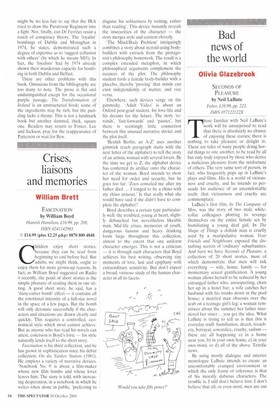Crises, liaisons and memories
William Brett
FASCINATION by William Boyd 1-famish Hamilton, £16.99, pp. 208, ISBN 0241142903
£14.99 (plus /2.25 p&p) 0870 800 4848 Children enjoy short stories, because they can be read from beginning to end before bed. But adults, we might think, ought to enjoy them for more grown-up reasons. In fact, as William Boyd suggested on Radio 4 recently, the point of short stories is the simple pleasure of reading them in one sitting. A good short story, he said, has a 'daisy-cutter bomb' effect — it contains all the emotional intensity of a full-size novel in the space of a few pages. But the bomb will only detonate successfully if the characters and situations are drawn clearly and quickly. This requires a controlled, economical style which most cannot achieve. But as anyone who has read his novels can attest, concision is Boyd's forte — his style naturally lends itself to the short story.
Fascination is his third collection, and he has grown in sophistication since his debut collection. On the Yankee Station (1981). He employs a variety of narrative devices. 'Notebook No. 9' is about a film-maker whose new film bombs and whose lover leaves him. The story is told, with increasing desperation, in a notebook in which he writes when alone in public, 'preferring to disguise his solitariness by writing, rather than reading'. This device instantly reveals the insecurities of the character — the story merges style and content cleverly.
'The Mind/Body Problem' intriguingly combines a story about steroid-using bodybuilders with extracts from the protagonist's philosophy homework. The result is a complex extended metaphor, in which philosophical arguments complement the nuances of the plot. The philosophy student fools a female body-builder with a placebo, thereby 'proving' that minds can exist independently of matter, and vice versa.
Elsewhere, such devices verge on the gimmicky. 'Adult Video' is about an Oxford post-grad student, his love-life and his dreams for the future. The story 'rewinds', last-forwards' and 'pauses', but there is seemingly little connection between this unusual narrative device and the plot itself.
'Beulah Berlin, an A-Z' uses another gimmick (each paragraph starts with the next letter of the alphabet) to tell the story of an artistic woman with several lovers. By the time we get to Z, the alphabet device has conferred its artifice onto the character of the woman. Boyd intends to show her need for order and security, but he goes too far: 'Zoos consoled me after my father died ... I longed to be a rhino with my rhino armour.' Is that really what she would have said if she didn't have to complete the alphabet'?
Boyd describes a certain type particularly well: the troubled, young at heart, slightly debauched but nevertheless likeable man. Mid-life crises, memories of youth, dangerous liaisons and heavy drinking loom large throughout this collection, almost to the extent that one uniform character emerges. This is not a criticism — it is through such characters that Boyd achieves his best writing, observing tiny moments of love, lust and epiphany with extraordinary sensitivity. But don't expect a broad, virtuoso study of the human character in all its facets,


















































































































 Previous page
Previous page